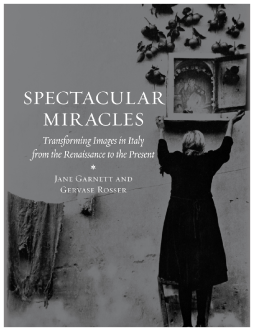
Additional Information
Book Details
Abstract
Winner of the ACE / Mercers' Book Award 2014
Spectacular Miracles confronts an enduring Western belief in the supernatural power of images: that a statue or painting of the Madonna can fly through the air, speak, weep, or produce miraculous cures. Although contrary to widely held assumptions, the cults of particular paintings and statues held to be miraculous have persisted beyond the middle ages into the present, even in a modern European city such as Genoa, the primary focus of this book.
Drawing upon rich documentation from northwest Italy and elsewhere, Spectacular Miracles shows how these images “work” in a range of historical contexts. Jane Garnett and Gervase Rosser vividly evoke ritual animation of the image and the phenomenology of the beholder’s experience. These images, they demonstrate, have the subversive potential of the miraculous image to bypass clerical and secular authority, a power enhanced by reproducibility—devotion is hard to control when a copy of a venerated image is held to carry the same supernatural potential as the original, even when in a digital form mediated by the Internet. Engaging with the history, anthropology, and visual culture of images and religion, Spectacular Miracles is a convincing study of the continuing power of faith and art.
“An impressively researched and perceptive study of miraculous images in Italy.”
— Apollo magazine, Richard Cork
“One of the great wonders of art and of human experience is the enduring belief that objects sometimes work miracles or possess other supernatural abilities. . . . This book addresses this essential phenomenon in Italian art. . . . The premise of the investigation is sound and reaffirms the image’s power to affect human beings. . . . Thought-provoking study. Recommended.”
— Choice
“This interdisciplinary study brings together art history and anthropology to explore those paintings and statues which have been invested with miraculous properties by believers. Focusing on art and faith in Genoa and its surrounding region, the authors investigate how such objects have historically subverted their intended clerical or secular function—and in many cases, continue to do so.”
— Apollo
“Analysing how miraculous images ‘work’ in their social context is the focus of the book. It is the product of years of study—mixing history, anthropology, sociology, and art history. . . . Through the rich collection of illustrations, the volume encourages us to look at the images in a new way, by understanding their social lives, from the Renaissance to the internet age.”
— Journal of Ecclesiastical History
“The book demonstrates the ways in which image cults are built into the fabric of daily life—the images themselves are seen, touched, and even tasted, and their representations can be found in all parts of the everyday world. . . . It’s clearly and engagingly written; no real prior knowledge of the subject is needed. Image cults often rely on overpowering visual stimulation to give their devotional foci power. Fittingly, then, this book is absolutely gorgeous. The paper stock is glossy and heavy, showing off the over 150 images—most of them in colour—to best advantage. The lavish production values and comprehensive, sympathetic view of the topic make this a valuable addition to the library of anyone interested in popular religion.”
— Fortean Times
“Through sumptuous photographs, rich unpublished sources, and years of fieldwork, Spectacular Miracles reveals with sensitivity and insight the long, cumulative history of commingling and exchange between the devout of northern Italy and their sacred protectors. It is a magnificent achievement—a blaze of beauty, a sweep of time.”
— William A. Christian Jr., author of Divine Presence in Spain and Western Europe, 1500-1960
“‘The miracle-working image opens the realms of space and time to spiritual experience. As this beautifully written book recovers the local histories and the cultural significance of the transforming image, it reveals a new territory—between the academic disciplines, the secular and the profane, the high and the low—of the power of image in the individual encounter. Anyone with an interest in the visual image should read this book.”
— Karen Lang, University of Warwick and Editor-in-Chief, Art Bulletin
Jane Garnett is a fellow and tutor in history at Wadham College, Oxford, UK. She has published and taught widely on the history of Christianity, visual culture, gender, and philosophy. Gervase Rosser is a fellow and tutor in the history of art at St Catherine’s College, Oxford, UK. His research and publications have focused on the social, visual, and religious culture of medieval and Renaissance cities.
